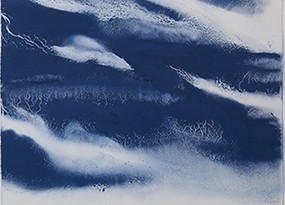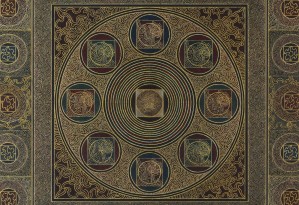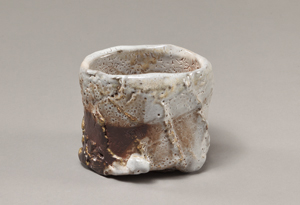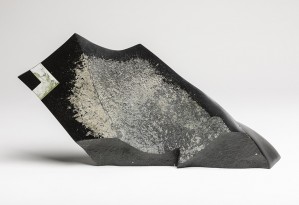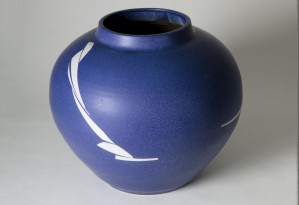FENAROLI Flavia, sculpture
In the contemporary creation, in particular in the field of the ‘volume’ and of its widened field, we have practices very far from those formely current in the schools of art.
The importance of materials, of all the raw materials, has increased, the practice of the ‘fragment’ has become widespread; the loss of a notion of monumentality that was traditional in the field of sculpture has also increased.
Opens for us, a vast field of reflections centered on the materials of the art, their logic, their own thought and on the current behaviors and processes in regard with the past.
Flavia Fenaroli – Statements
Biography
(born in 1955 in London)
Most of my studies took place in Milan, at Brera, a renowned academy of fine arts, a "monumental" school that included the Lyceum, the Academy, the observatory, the Pinacoteca and also a wonderful library.
The palace dates back to the 17th century, and in its inner courtyard stands the Napoleon of Antoine Canova.
This choice was supported by my family and friends who had opened an important art print shop, well known today, the 2 RC, on the edge of the Foro Romano.
The printer-publisher Walter Rossi and his wife Eleanora worked with artists from all over the world (Chillida, Moore, Nevelson, Afro, Segal, Burri...). I was able to meet the artists who came to work on site assisted in their projects.
It was often about the realization of prints of exceptional size with sometimes experimental techniques.
For the engravings of the American artist Georges Segal, the whole team had literally lent their bodies, dressed only in jeans, to take prints that were translated and engraved on copper plates before being printed on paper.
I saw the realization of Burri's Cretti, a real feat on paper, or that of engravings for Chillida. It was an opening towards artistic forms that were not very present or known in the teaching of the time, which was extremely traditional. The taste for engraving has always remained with me, applied especially to the realization of artists' books in gravure.
During my years of study in Milan, the country was in crisis, politically and culturally destabilized by violent terrorist attacks (the "Lead Years"); the social, cultural and political values that had been passed on to us were totally challenged.
Nearby our Academy was the Bank of Piazza Fontana, which was the target of an attack in 1969, the first of a long series.
In this period of social, political and cultural uncertainty, we received an artistic education that had been unchanging for generations, detached from a reflection on our time.
Drawing and copying (capitals, ornaments, copying of Greek and Roman sculptures), copying of antiques in modeling. Hierarchization of disciplines and techniques, consideration given to the central perspective as the only means of translating reality into artistic work. This was the legacy of the 19th century. We had teachers, some of them passionate, in philosophy, art history, architecture and Ornato who were fighting to transform the school.
Ornato was traditionally a course in the design of all things ornamental (moldings, capitals, etc...). We were lucky enough to find ourselves in a "pilot" class that Luisa Spinatelli, a well-known set designer, had transformed into a Visual Design course before the letter. This transformed course allowed us to study what we now call visual communication. We thus partially escaped one of the most boring subjects.
In the other courses, including Figura, we continued the tradition of drawing from copies of antiques, before tackling the live model; and in Plastica, modeling from the antique; in this last course the sculptor Giacomo Benevelli, our teacher, while respecting the school's program, also made us work experimentally on volume with clay, plaster, or cardboard and scissors, on projects reminiscent of the achrome works of Enrico Castellani or Manzoni.
It was a different way of approaching sculpture, which allowed the teacher to be assisted on artistic projects related to Industrial Design, of which he was a well-known representative.
We finished our studies in this troubled period, with the feeling of a fracture between our need to "do" and the feeling that the teaching we had received and its certainties, no longer answered the questions we were asking ourselves about art, its role and the evolution of our society.
We were in a real loss of reference points, as had been the artists practicing at the end of the second world war. At that time, the great assemblies against the Vietnam War led by older students were also beginning. The Academy of Fine Arts was often occupied. The academic world remained relatively immobile. But above all, apart from the protest movements, these were years of terrorism and attacks that accompanied a form of general social disintegration, the world seemed to us for the first time to be extremely violent.
There was a beautiful film made for television in 2003: Our best years (La nostra meglio gioventù) by Marco Tullio Giordana, which describes the terrorism, the strikes, the opening of psychiatric spaces, the rebellion of schools during those years, the uselessness of their studies, denounced by the students. However, the gap that we felt between the education given and life, existed long before us.
Arturo Martini, important sculptor, solicited by the state in numerous commissions testified to this phase shift already in 1946, in La sculpture langue morte, where he questioned the foundations of sculpture as he had learned them.
In this short poetic text, he returns to concepts that were fundamental to him: to conceive of sculpture in terms of measurement, (measurability), of gravity, of transformation. He introduces, albeit indirectly, data not taken into account by traditional teaching, data that could be called anthropological, such as the concepts of contact, touch, the rediscovery of the role of the physical body in the creation of a work, the role and meaning of the materials of sculpture.
In the teaching we received, the representation of space was that inherited from the Renaissance, marked by the central perspective, the supremacy of drawing, the separation from those who were thought of as "mechanical" arts, i.e., manual, and finally frozen in a visual convention that codified representation in a purely optical sense for centuries.
It is this search for meaning, pursued by sculptors who have meant a lot to me such as Luciano Fabro, that will nourish my future work when I arrived in Paris in Jean Cardot's direct carving workshop. It should be noted that in the sculpture workshops of the art schools that I knew, first in Milan and then in Paris, we always worked in a form of translation which from a first model in clay, led to the plaster, transposed then in bronze or in stone.
In itself, the manufacturing process counted for little and its different stages were often left to specialized craftsmen; moreover, the molding teacher at the Beaux-Arts de Paris was a craftsman, whereas in other workshops it was professor-artists who gave the courses.
However, it was through the stone cutting practiced in the Jean Cardot workshop that the writings of Arturo Martini and those of Luciano Fabro had a greater resonance for me.
It is also at the same time that in Paris took place a big exhibition of Luciano Fabro to the Museum of Modern Art, an important exhibition and a big lesson.
Jean Cardot's workshop was a direct carving workshop (stone, marble, wood). We were fortunate to have at our disposal large blocks of marble and the advice of a stone cutter who was the teacher's assistant and who guided us.
The interest in working directly with stone was relatively recent, since until the 1940s there was only one small practical sculpture workshop at the Beaux-Arts de Paris (opened in 1883) and this work had been reserved a century earlier for practitioners only.
The direct work with stone re-evaluated behaviors far from the received teaching, re-evaluated gestures coming from a time when transforming, weighing, transporting or even sewing and assembling had a meaning close to man and truth.
I perceived in this work linked to an almost artisanal manuality, far from the hours of laborious copies of Corinthian capitals and antique casts, that sculpture was rooted in life; each material had its own logic if not its own thought, that we could think by and through the materials of art and that it was important, for the subjects that I cared about, to evolve in this sense.
In stone carving, I discovered another relationship with time and the body. When the point hooked on the stone, it resonated in the body. The rhythm of the strike had a particular sonority that the body felt right, or sometimes wrong and hurtful by the metallic sound it produced on the mineral matter. The stone responded softly and in harmony when it received the tool in the right way.
At the end of the day, our exhausted bodies became as heavy as the block we were working. Sitting in front of our saddle, the physical effort became simply "thought".
At the end of the day, in the fading daylight, we could see dark silhouettes sitting motionless next to very white blocks, in a white dust and an unreal silence.
From this period, I retain that the approach of direct carving offered something other than the repetition in a block made by a practitioner, of a form initially in plaster; showed that this relationship to the material was something much more than a simple transposition.
It showed that thinking, carrying, balancing the weights during the work were significant gestures, they participated in an ancient gesture, a reduced technology where the anthropological factors, the "fact of the body", had a meaning.
I had to relearn, to become again the man-craftsman, the Artifex who transforms the raw material by the work of the hand and also his whole body. We no longer have to hierarchize the materials of art, many of those that we think of today as significant are those that were once used in subaltern workshop practices, cultural or social practices, often intimately linked to the idea of life and death as with wax for example.
In my "relearning" I was able to integrate for several months, a training center for boilermakers (AFPAA) which was located in the industrial zone of Meudon. I took the whole path backwards, in very different environments and far from an art academy to "relearn" humbly. In spite of my atypical profile as a "boilermaker", I was well received (under the conditions of the learning center, of course): there was no question of coming to make one's own sculpture: one had to know how to bend, weld, make a box, a shovel, a boiler connection!
I was certainly not their best recruit (and by far!!), but the spirit of companionship of the workshop compensated for my shortcomings and my impractical spirit, although my workshop colleagues wondered about my obstinacy in making shapes that were "useless"!
This technical and not very playful training allowed me to envisage in a different way the work of steel, a living material that we can shape without going through a melting, work in depth, on the surface, engrave endlessly to give it a particular depth or work in a forge. I used a coal forge to make Shelter, a series of sculptures whose subject was linked to the clashes in the Balkans.
Working in a forge is hard and we are quickly confronted with our physical limits but we learn a lot.
During this period, I also wanted to develop "body sculptures", objects/sculptures to be worn like jewels, in different alloys, precious or not. Kinds of nomadic objects, identities, functioning as "assistants", as witnesses of us, of our history, of our uprootedness. Often these objects to be worn are part of a sculpture from which they can be detached, taken away, they are hybrid objects which lead us mentally back to a place sometimes definitively lost, to a person...
They also allow me to develop projects undertaken in sculpture like the Europa series on our European spaces and borders. This subject is taken up again in a series of six silver embossed reliefs (to be endorsed) showing the mountainous reliefs of the continent, its borders, its sometimes "mobile" confines. Indeed, the alpine glaciers move, transforming the natural borders of separation as for example with Switzerland, which has become among other things, an object of contestation from the States.
Or I like the idea of the sculpture/matrix that integrates an object that can be worn, as in Melancholia and Point d'équilibre II.
Before that I had been for a time, "little hand" at a master glassmaker. His workshop was located in Normandy in Clachaloze in an unheated troglodyte cave, where in winter we had to break the ice on the surface of the buckets to get some water for the moldings.
There, I improved my knowledge in molding, wax work, glass paste, I had the opportunity to participate in the restoration, by Olivier Juteau, of the stained-glass windows of François Décorchemont (ceramist and master glassmaker, 1880-1971), in crystal, cement and metal.
Décorchemont had made stained glass windows in the 1930s. The structure that held the glass paste in place was made of cement and not of lead as traditionally. The cement had aged very badly, had moved or had crumbled. We had to reconstitute the same type of glass for the damaged parts, find the tints, redesign the structure, module by module.
Each small part of the stained glass had to be individually imprinted in order to create a new crystal form where each color was subject to multiple shade tests.
In this workshop I was able to create sculptures in glass paste and steel, the series Angels; to test and deepen a technique that I now try to share at the Potager du Dauphin (within the Academy of Meudon).
Later, with Bibliothèques errantes, Bandes Magnétiques and Patrarca, I created sculptures about the violent destruction of our cultural heritage; in Petrarca the work on steel was mixed with that on lead which became the engraved support of the founding texts of our humanism, or again in the series of Bibliothèques it was about the history of the destruction of these over time, conflicts or intolerance.
Today, with the Europa series, I work on the reliefs and borders of Europe, the permanent instability of our geography, by creating a kind of "landscape" in pressed steel with the imaginary cartography of our continent.
After years in shared workshops or located in impossible areas, my work is now done in Sèvres. The studio has more the aspect of a craftsman's workshop in the sense that my work is not exposed or only partially visible; only the working tools appear, the work in progress. I need to evacuate the work done, like a book that closes, to renew a research.
I have accumulated in this place the legacy of several artists or even coppersmiths and goldsmiths that I have been able to work with and who, sometimes too old, gave up or sold their workshop funds so that their work could be perpetuated elsewhere. Thus, this place resembles one of those popular workshops in Paris that existed 15 years ago where artists invested in places that were formerly artisanal and sometimes still heated with coal.
In these workshops our work was easier than today; small shops (glass blower, miller, sheet metal workers) were installed in the same courtyard, jewelers worked in their apartments, it was enough to open one's door to find the necessary trade for a collaboration. The artists of a generation before mine often had their marks there: like Coutelle's workshop, always surrounded by a group of students who learned while working for the artist.
In these places, which have now almost disappeared, all types of artists' and craftsmen's studios mixed together and there was a real respect between the different "trades", the artist spoke about his "trade"; it was also appreciated, in a milieu that was then extremely masculine, that as a woman you could be technically credible. It was the unspoken condition to have its place, then there were no more differences, one was on the ground of the respect towards the work which for the artists, as for the craftsman of art, connects the spirituality of the research to a body-tool.
Today, the young artists carry for some, the same need of a total physical, corporal participation as much as technical and spiritual to their work. This is not a backward-looking position.
It is, I believe, in this very old link found that our word can today be resourced and enriched. We find the assumed need to renew a very old language which fights not to disappear completely and continues, without real hope of survival, to be full of hope.
Exhibitions (since 2001)
2020/21 Miroir, Galerie Schumm-Braunstein, Paris, France
Galerie Collection, Paris, France
Galerie Valérie Guérin, Paris, France
2019 Musée Rodin de Meudon, exhibition of the sculpture Petrarca, Meudon, France
La Maison de la Parole, Meudon, France
Private Choice, Galerie Mini Master Pieces, Paris, France
2018 Pages, Exhibition of bibliophily and artist's books, Paris, France
Délires de Livres, Ecu de France, Viroflay, France
Galerie Mini Master Pieces, Paris, France
2017 Collective Design, New York, USA
Galerie Mini Master Pieces, Paris, France
Page, Galerie Schumm-Braunstein, Paris, France
Soon, Galerie Schumm-Braunstein, Paris, France
Parcours du bijou, Materia, Galerie l’Objet Rare, Paris, France
Palimpsestes, Galerie Schumm-Braunstein, Paris, France
Codex, International book Fair, Richmond (CA), USA
Impressions, La Chartreuse Art Contemporain, Sèvres, France
2016 Prima Materia, Galerie Résidences, Paris, France
2015 Jeux de mots, Galerie Collection, Paris, France
Japan Cultural Center, Paris, France
2014 Les cinq éléments, Opus la Terre, Baccarat Pôle bijou, Baccarat, France
Karfunkelschein, Handwerksform Hanover, Hanover, Germany
Relevés, Galerie Schumm-Braunstein, Paris, France
Graver maintenant, Ermitage et Atelier Grognard, Rueil Malmaison, France
D’or et d’acier, Atelier Chérét, Paris, France
2013 Bibliothèques, Galerie Schumm-Braunstein, Paris, France
Filo rosso (Circuit du bijou), Boutique Agatha Ruiz de la Prada, Paris, France
Ring Party, Padova, Italia
Marché de la Poésie, Galerie Schumm-Braunstein, Paris, France
Salon de l’Estampe et du Dessin avec la Galerie Schumm-Braunstein, Grand Palais, Paris, France
2012 Staufishe Pracht & Karfunkelschein, Galerie Im Prediger, Schwäbisch Gmünd, Germany
Le corps, Salle Samonà, Padoue, Italia
Salon de l’Estampe et du Dessin avec la Galerie Schumm-Braunstein, Grand Palais, Paris, France
Il ne restera que du bleu, Galerie Schumm-Braunstein, Paris, France
Graver maintenant, Espace Renoir, Rueil Malmaison, France
2011 Stampe-Stampe-Stampe, Galerie Schumm-Braunstein, Paris, France
Mostra di Palazzo Libera, Villa Lagarina, Italia
Pin Anonimum, Lisbonne, Portugal
Délires de Livres, Chartres, France
Paysages, Médiathèque de Chartres, France
Hors du lisible, Centre d’art Saint Louis, Bar le Duc, France
CAC, Centre d’art Meudon, Meudon, France
2010 Artist Book, Centre Pompidou Paris, France
Premio Fondazione Cominelli, Salo‘, Italia
O’noff, Spazio Aperto-Padova, Italia
Oratorio San Rocco, Padova, Italia
Chiesa dell’Angelo, Bassano del Grappa, Italia
Galerie Schumm-Braunstein, Paris, France
2009 Salon Page(s), Paris, France
Noir Papier, Galerie Schumm-Braunstein, Paris, France
Centre d’art contemporain A. Chanot, Paris, France
2008 Galerie DH. Nick, Montpellier, France
Galerie Schumm-Braunstein, Paris, France
2007 Sculptures et estampes, Galerie DH. Nick, Montpellier, France
Galerie Schumm-Braunstein, Paris, France
2006 Triennale de Chamalières, Chamalières, France
Galerie Michèle Guérin, Limetz-Villez, France
2004/05 Galerie Michèle Guérin, Limetz-Villez, France
2003 Le Trait, Cité Internationale, Paris, France
2002 Salon de Montrouge, Montrouge, France
Affordable Art Fair, Londres, UK
2001 Matière Première, Château de Morsang sur Orge, Morsang sur Orge, France
L’art contemporain au risque du clonage, Chilly-Mazarin, France
Galerie des Tournelles, Paris, France
La subversion, Château de Morsang sur Orge, Morsang sur Orge, France












